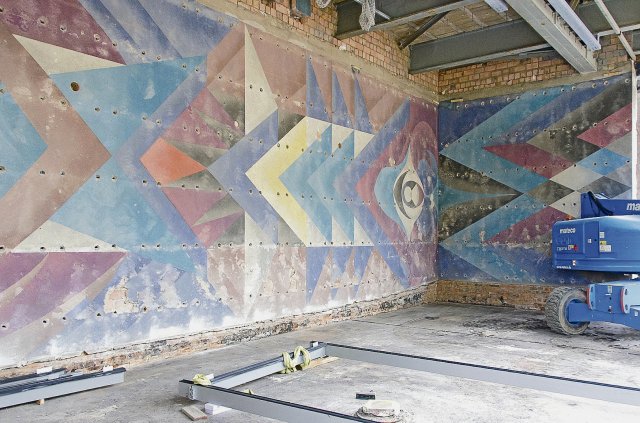Colorful and agitational at most at the tenth glance: the mural by the Dresden artists Karl-Heinz Adler and Friedrich Kracht.
Photo: Wüstenrot Foundation/Martin Fliedner
Perhaps the delivery times for sandstone in the GDR were similar to those for a “Trabant”. For small cars, it often took a decade between ordering and delivery. Sandstone was probably similarly rare, and that is why wall cladding made of the material could not initially be installed when a modernist new building was inaugurated at the town hall in Plauen in Vogtland in 1976. Its glass facade opens onto a foyer, the walls of which were initially adorned with a mural by Dresden artists Karl-Heinz Adler and Friedrich Kracht. Only ten years later, however, it disappeared behind the said sandstone. Due to the lack of documentation, we can only speculate about the reasons. “Perhaps,” says Dagmar Groß, “the ordered contingent of stones was finally available?!”
Dagmar Groß works for the Lower Monuments Authority in the Plauen town hall and was instrumental in ensuring that the mural was uncovered and renovated again 38 years after it was covered. It was forgotten for decades; only passionate art lovers like Dietrich Kelterer, chairman of the local art association, remembered it. When the Plauen city council began debating in 2018 whether the foyer building from the GDR era should be replaced with a new building or renovated, Kelterer pointed out the mural. Experts conducted some sort of archaeological survey and found it in good condition. Monument conservationist Groß initiated contact with the Wüstenrot Foundation, which has been supporting the renovation of building-related art from the GDR since 2019 and has provided 165,000 euros for the Plauen project. The mural in the town hall has now been returned to the public. Foundation managing director Philip Kurz speaks of a “work that captivates you and eludes what we otherwise know of construction-related art from the GDR.”
When we talk about art in architecture in the GDR, we think of murals such as the 35-meter-high work “Unity of the Working Class and the Founding of the GDR” created by the Spanish artist Josep Renau and recently renovated with the help of the Wüstenrot Foundation adorns an eleven-story building in Halle-Neustadt and shows Karl Marx looking over workers’ marching blocks. Less agitational, but also figurative and characterized by the spirit of optimism in the young GDR, is Gerhard Richter’s 1956 diploma thesis in the German Hygiene Museum in Dresden. It was also later covered up and is currently being uncovered again.
The image of Adler and Kracht in Plauen, 20 years younger, is completely different. It does not show worker leaders or scientists, peace doves or space rockets, but rather rhythmically arranged and interpenetrating geometric shapes: wedges, arrows and circles that give the work dynamism. The color spectrum extends from umber and violet to the orange and yellow of a circular area reminiscent of a sun.
Such a work is not necessarily what would be expected in a GDR administrative headquarters. Whether the draft caused cultural policy debates: There are no documents on this either. “If you wanted, you could of course give it a political interpretation,” says Saxony’s state curator Alf Furkert. “From darkness to light, from the past to the present: This is how smart artists were able to convince those responsible.” Whether this was necessary in 1976 remains to be seen. A few years earlier the idea would have been rejected as formalistic. Such artistic approaches were later tolerated, says Furkert, recalling the prominent constructivist Hermann Glöckner, who was recently represented at GDR art exhibitions.
Adler and Kracht had made a name for themselves in the field of construction-related art since 1960. The two artists, who were organized with colleagues in Dresden in a “Handicraft Production Cooperative” (PGH), designed a range of serial shaped concrete blocks that were ubiquitous in the GDR: in department stores, but also at the state security district office in Leipzig. The shapes used to cover their stairwells were reminiscent of ears, says Furkert: possibly an ironic dig at the institution that was ridiculed as “VEB Horch & Guck”.
Adler and Kracht created the mural in Plauen using a specially developed, experimental technology. Colored glass shards were applied using a spray gun using the patented process. The result was very robust, says Martin Fliedner, restorer of the Plauen work of art. He was faced with the task of removing not only the sandstone slabs, but also thick layers of grouting mortar. This was achieved by sandblasting. The picture was not damaged but was “presentable to restore.”
After five years of work, the 250 square meter picture can now be seen again. The glass splinters ensure impressive plasticity and radiance. The color effect, says Fliedner, changes with the change from daylight to artificial lighting and varies depending on the position of the sun. The retouching of 855 holes in which drill anchors were inserted to fasten the sandstone slabs was a challenge. They can be seen in certain lighting conditions. No problem, says Fliedner: “A principle of our work is that the restoration can be readable in the work.”
With the restoration in Plauen, “one of the most idiosyncratic creations of a public building from the GDR” has been restored, says Furkert. She is not unique. Adler and Kracht created additional murals using their glass splinter technology, at least one of which survives in Zwickau. It is outdoors; Experts say its condition is poor and they hope that restoration will be successful there too. Plauen’s mayor Steffen Zenner wants to invite local politicians from Zwickau for inspiration. Maybe there will be a rediscovery there too.
Subscribe to the “nd”
Being left is complicated.
We keep track!
With our digital promotional subscription you can read all issues of »nd« digitally (nd.App or nd.Epaper) for little money at home or on the go.
Subscribe now!
